The middle class — which President López Obrador characterized last week as a political opponent — forms 41% of Mexican households.
About 14.5 million families belong to that segment of the population, according to the 2020 census and data from the Mexican Association of Market Research Agencies (AMAI).
The ruling Morena party fared poorly in the June 6 midterm elections in states and in boroughs of the capital which have large middle class populations.
Since the elections AMLO, as the president is commonly known, has spent time dissecting the outcome at his morning press conferences and on Friday, the middle class became a new target for criticism. He branded the segment “aspirational and selfish” and suggested middle class Mexicans want “to succeed at all costs.”
But they are not generally fans of Morena, at least not any more.
López Obrador observed that members of the middle class with higher educational qualifications were “very difficult to convince” of his political project.
Morena prospered in the governors’ race, but lost in states with a large middle class. The opposition took Nuevo León, where 56.1% of households fall in that bracket, the highest proportion in the country. It also triumphed in Chihuahua and Querétaro where 48.5% of households are defined as middle class.
Similarly, in Mexico City nine of 16 boroughs went to the opposition, where overall 51.1% of homes sit within the middle class bracket.
The ruling party took five states where middle class presence is low: Guerrero, with 24.8%; Campeche, 33.8%; Tlaxcala and Michoacán, both with 37.6%; and Nayarit, 39.4%.
However, in one state with the middle class segment measuring 38.8% of households voters opted for a rival left wing opponent: a Green Party-Labor Party coalition won in San Luis Potosí.
Morena secretary general Citlalli Hernández says the party’s losses in Mexico City show that it is out of touch with voters in the segment. “We have have been losing the ability to create a narrative that connects with the middle class that traditionally supported us,” she said.
She also referred to a “dirty war” by traditional media against the administration, an idea that the president has consistently promoted, and disagreed that the intensity of the Covid-19 pandemic in the capital or the Metro disaster in May, which killed 26 people, were decisive.
Statisticians have a hard time delineating class brackets for population analyses. The national statistics institute, Inegi, uses a range of qualitative variables, like educational level, alongside household spending and income.
However, Inegi says purely econometric studies have placed a similar proportion of the households in the middle class segment. One such study, published for the Organization for Economic Co-operation and Development, defined the middle class by a monthly income range of $6,260 (about US $300) to $16,700 ($840).
With reports from AP and El Universal
